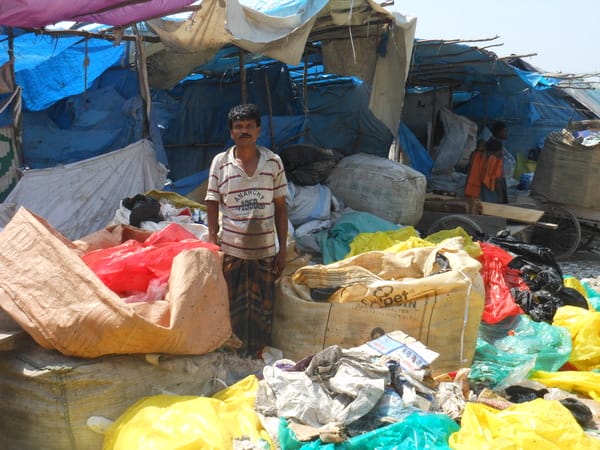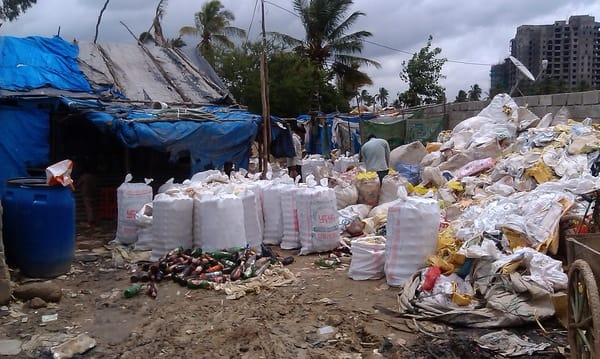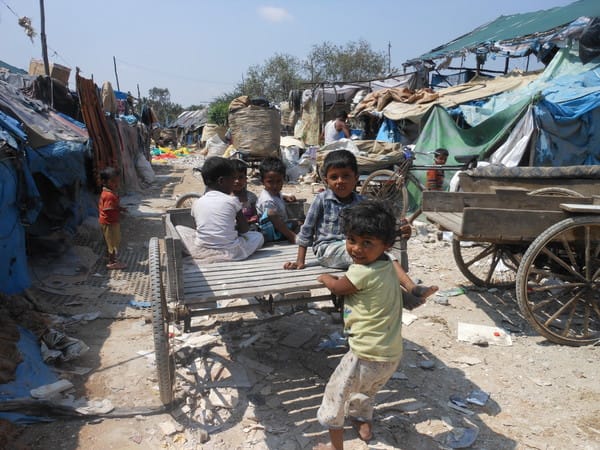While aiming for the sun high up in the sky, we tend to stamp on the flowers at our feet.
– Anonymous
We continue to mix waste, violate laws and lead ‘respectable’ lives. But these people, who help reduce the trash in our mega-city Bengaluru, are looked down upon for being migrant and poor. Be it ragpickers, sweepers or garbage collectors, they are part of the system too. But their stories are never told.
Mohammad Khan (name changed on request) has a long and grey beard that seems to represent his 60 years of experience. Dressed usually in ragged trousers or lungi, he, like others in his neighbourhood, pedals from street to street, hunting for plastic waste to fill up his big gunny bag.
Citizen Matters spoke to Khan and a dozen of his friends to understand who they are and what they do.

Waste pickers of Bellandur. Pic: Nikita Malusare
Plastic items like bottles, polythene bags, milk bags, food dabbas, copper wire, nail etc. help them earn a livelihood. The BBMP and garbage contract workers are not comfortable with them as they see them as competition.So, they usually prefer to operate at night when BBMP pourakarmikas are not present.
Life is a bit more pleasant to them, of late. Petty shopkeepers or watchmen who were strangers to them earlier, now recognise them. Shopkeepers have started keeping plastics aside for these people to take.
Who are they?
Mohammad Khan says they have migrated from the North-east India and have formed their own small little community at Bellandur, off Outer Ring Road, in some makeshift tents. Such makeshift settlements are spread across the city. All the residents do the same job – collecting and segregating waste. Bellandur alone has 10 such colonies.
Their segregation job is recognised by the BBMP. Their ‘leader’ got them the identity cards allotted by BBMP, Solid Waste Management Cell, that recognises them as authorised waste segregators.
The living condition of this community is not great. But you will see a smile on their face. They don’t have television sets, but they fo have legal power connections from BESCOM. They pay Rs 5,000 approximately for the connection which is shared by the 250 families living in the colony.
“Two years ago, I was at Delhi without a job when my friend told me about this work. Me and my friends decided to come down. Along with our families, we shifted and settled down here. Who doesn’t seize a job opportunity—whether big or small?” he asks.

Plastic and metal waste segregated and kept neatly. Pic: Nikita Malusare
What do they do?
These settlers collect plastic and hazardous waste from nearby apartments and segregate them outside their homes. They separate it into paper, carton boxes, plastic box, polythene bag, tetra packs, thick plastics, bottles and other categories. If any item is not clean or has any left over, they wash it and keep it for drying.
“Four times a month, lorries come and take away the segregated things to their factories. They weigh the waste and pay us as per the contract between them and our landlord,” says another waste segregator, Abdul Khan.
However, a percentage of the amount is retained by the landlord, which is considered as the compensation for land given to them. The rest is given to them as income.
“If we sell the plastic outside directly, we may earn Rs 5 extra on every kg,” says Abdul Khan. But they don’t want to move out of the comfort and the security offered by the landlord here. They are content with only half the actual possible income.
The men stay with their families. The women work as domestic workers in nearby apartments, while their children are sometimes spotted loitering around nearby or around the city.

Kids of waste pickers playing in the settlement Pic: Nikita Malusare
What do the kids do?
Nayan, 12 years old doesn’t want to go to school as he wanted to support his unwell father. He has two younger brother, a sister and his parents to take care of.
Most children in this community mostly roam around with a small gunny bag hanging on their shoulder and join the collection expedition.
Some people who can afford have put their children in model government school. Those who can’t go to school go to a lady who teaches them for free of cost. There is also one Sayed Khan who teaches them Urdu.
In the month of October, kids as young as 6 to 7 years were spotted walking down the street with gunny bags really make for a sorry scene. But it is equally heartening to see how they help each other and get excited on spotting a plastic lying on the road. They jump on seeing a black garbage bag and dig into it for plastic with bare hands. Eventuallythey mess up the place as the garbage is left open on the street. Even as they leave with dirty hands, their zeal brings a smile to your face. Such visits by kids now have been reduced considerably.
Police threats
Most people here prefer operating in the morning hours at 4 am or 5 am to avoid being harassed by the public or the police.
Yes right, police threats and rounds are usual for them. They say the police come to harass them for some money. Sometimes they are even suspected for petty crime that happens around the city. “Karta koi aur hai bharta koi aur! (One does the crime but someone else pays for it!).” They are the usual suspects as they work late in the night.
“They arrest us, keep us in the jail for a fortnight. When they realise that we are incapable of doing any big robbery, they leave us with swollen eyes and reddened backs.”